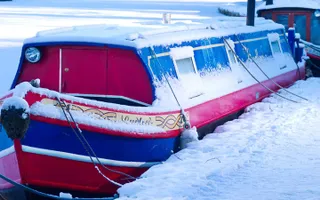The autumn and winter months can also bring rain and mud to our towpaths, making the surfaces very slippery. Please watch your step.
Winter water safety
Our waterways are beautiful places to explore in all seasons, and winter with its snowy landscapes and frosty mornings can be a great time to visit your local canal.
As the temperature drops further, there are some important potential hazards to be aware of.
Be prepared
How to stay safe on the canal:
- Plan your route – think about where you want to go and how long you want to be out for
- Take a friend – it is safer to walk with others
- Slow down – the colder it gets, the greater the likelihood of icy and slippery surfaces underfoot. It's easier to stay safe, spot potential hazards and avoid accidents near water when you reduce your speed
- Tell someone where you are going – in case you are out for much longer than you say, you can be found more easily
- Stay away from the edge - although you may be able to see the edge of the towpath even in the snow, it may be slippery
- Check the weather – look at the forecast and see what's coming your way
- Wear the right clothing – waterproofs, sturdy footwear, warm layers can all help your body cope with the wintry conditions
- Take your phone (or even a whistle) – if you get into trouble, or see somebody else in trouble, you can call or whistle for help
- Teach children not to go on the ice – it's important for children not to go on the ice under any circumstances
- Try to keep to well-lit areas - time your walks to make the most of the daylight; if you need to walk in the evening only use well-lit areas or take a route away from water
- Keep dogs on their leads – keep dogs on their leads when near ice and don't throw sticks or toys onto the ice
Take care when out walking, running or cycling in wintery or wet weather. The Trust does not intentionally grit as standard. We will only grit when it has been deemed as required by a site specific risk assessment. Therefore, appropriate footwear or tyres for your bike are highly recommended.
What to do if you fall in
Read the video transcript
My name’s Shammi Rana from the West Midlands Fire Service. I’m here with the Canal & River Trust, and we’re here to offer some advice on what to do if you fall in the water this winter.
First off, mind your surroundings. Even if you know the towpath well, it can be slippery and icy. If you do fall in the water, it will be very cold. Try not to panic, but if you can, call for help. Try to control your breathing by taking deep breaths. Canals can be quite shallow. If you can, stay calm and try to stand up. Try to make your way out to the towpath and look for a way out. It might be difficult to pull yourself out as wet clothes can be very heavy. If you can’t get out, stay calm and keep calling for help until it arrives. If you try to stand up and can’t touch the bottom, then float onto your back into a star shape. Shout for help, and wait for that help to arrive.
So, to recap, be careful when you’re next to water. If you do fall in, call for help. If you can, stand up and look for a way out. If you can’t stand up, lie on your back and wait for help to arrive. So, be water-safe this winter.
What to do if you see someone in the water
Don't get into the water, instead:
- Call the emergency services on 999 as soon possible
- Keep an eye on the person
- Keep talking to them, and stay near them
- If you can, throw line to them or use a tree branch to reach out to them
Even strong swimmers may face difficulties in icy water
You may feel you can help by getting into the water too, but remember that the water is freezing:
- All year round the shock of the cold water can really take your breath away and cause your muscles to cramp, making it very difficult for you to stay afloat
- There may be objects hidden under the water that could cause you harm
- The water may be deeper than you think. Canals don't normally have sloping sides and there are only ladders at locks so it's not easy to get out – especially wearing heavy, wet clothes and helping someone else
- Staying on the surface is much harder when you are trying to help someone else, they may panic and push you under
- Boaters might not be able to see you in or under the water and won't know to stop – if a boat hits you it can cause serious harm to you and the other person
What to do if your dog gets into the water
Please keep your dog on a short lead along the towpaths so they don't run off and risk jumping into the water. If your dog does go into the water, don't jump in after it, instead:
- Encourage your dog to swim over to you where you can lift them out more safely
- If they are unable to do this, try to reach them with a line or long branch
For more advice on keeping safe by the water this winter see the RLSS (Royal Life Saving Society UK) website.
Last Edited: 19 November 2025


Stay connected
Sign up to our newsletter and discover how we protect canals and help nature thrive



